I'm a researcher, author, lecturer, and entrepreneur whose work spans climate solutions, critical thinking skills, and the energy and environmental effects of information technology.
Don't wanna be here? Send us removal request.
Text
Our new report on digital twins for data center operations, out today!
The modern data center lies at the heart of today’s digital global economy, performing computing tasks like e-commerce, communications, search, financial modeling, and artificial intelligence (AI). Data centers undergo constant change, both in the workloads they run 24x7 and the hardware that runs those applications.
Lack of adequate planning and management can lead to under-provisioning, over-heating, and lost capacity, all of which undermine the profitability and sustainability of these critical facilities. Today’s AI and high-performance compute nodes can exacerbate these problems.
When IT loads deviate from the original data center design, stranded power and cooling capacity are the result. A simple analogy helps explain the problem. Most people are familiar with the game of Tetris TM, in which blocks fall at a regular pace, and the player's task is to place those blocks in the correct orientation, filling up the space as thoroughly as possible.
In the simplest case, the blocks are of uniform size and shape (i.e., they conform precisely to what data center designers specified initially), and it's easy for the user to fill up the space completely. The example on the left-hand side of Figure 1 illustrates this case. On the right-hand side, the TetrisTM player cannot make the shapes fit perfectly because their shapes are random, and they just keep coming. That leaves gaps (white space) between the shapes, which represent lost capacityin the data center. White space above the colored bricks represents unused capacity.

Figure 1: Lost capacity as illustrated by the game of Tetris
Lost data center capacity is exactly analogous to what are often called “zombie servers” in data centers, which are servers using electricity but doing nothing useful. This time it’s part of the data center itself (the cooling and power infrastructure) that is costing money (and lots of it) but not enabling any useful computing.
In this paper, we describe the challenges data center planners face and the potential for digital twins to help better manage data centers over their useful lives. Combining digital twins with computational fluid dynamics software (models that simulate and predict the behavior of airflow and heat in data centers) helps planners and managers save millions of dollars, reduce energy waste, increase profitability, improve data center reliability, predict failures, and lengthen the useful lifespan of costly data center equipment.
Download the report.
Download my talk titled "Fighting Zombie Data Centers with Digital Twins".
0 notes
Text
Our new article in Joule titled "To better understand AI’s growing energy use, analysts need a data revolution" was published online at Joule today

Our new article in Joule on data needs for understanding AI electricity use came out online today in Joule (link will be good until October 8, 2024). Here's the summary section:
As the famous quote from George Box goes, “All models are wrong, but some are useful.” Bottom-up AI data center models will never be a perfect crystal ball, but energy analysts can soon make them much more useful for decisionmakers if our identified critical data needs are met. Without better data, energy analysts may be forced to take several shortcuts that are more uncertain, less explanatory, less defensible, and less useful to policymakers, investors, the media, and the public. Meanwhile, all of these stakeholders deserve greater clarity on the scales and drivers of the electricity use of one of the most disruptive technologies in recent memory. One need only look to the history of cryptocurrency mining as a cautionary tale: after a long initial period of moderate growth, mining electricity demand rose rapidly. Meanwhile, energy analysts struggled to fill data and modeling gaps to quantify and explain that growth to policymakers—and to identify ways of mitigating it—especially at local levels where grids were at risk of stress. The electricity demand growth potential of AI data centers is much larger, so energy analysts must be better prepared. With the right support and partnerships, the energy analysis community is ready to take on the challenges of modeling a fast moving and uncertain sector, to continuously improve, and to bring much-needed scientific evidence to the table. Given the rapid growth of AI data center operations and investments, the time to act is now."
I worked with my longtime colleagues Eric Masanet and Nuoa Lei on this article.
1 note
·
View note
Text
KQED Forum today about our digital carbon footprint

My friend and colleague Danny Cullenward and I were on KQED Forum this morning, talking about the environmental impacts of our digital lives. Lesley McClurg was the host.
You shouldn't worry at all about your digital footprint, as we discussed in the show. It's small and constantly improving, and much of the equipment uses the same amount of electricity when it's idle as when it's fully loaded, so your actions won't change electricity use or emissions.
If you want to take personal action on climate, you should
* Vote against climate deniers and fossil fuel apologists. * Replace fossil fuel equipment at end of life with electrified equipment. That's when it's most cost effective. Buy heat pumps instead of furnaces, heat pump water heaters instead of normal water heaters, induction cooktops instead of gas cooktops, heat pump dryers instead of gas dryers, and electric vehicles instead of gasoline or diesel vehicles (if not ready for full electric, buy a plug in hybrid). * Fly less. * Drive less. * Eat less red meat. * Vote against climate deniers and fossil fuel apologists again!
Much of what needs to happen is to change our SYSTEMS, which is not under the control of most individuals, but the actions above are both under individual control and highly impactful. For more ideas, see our 2022 book:

Koomey, Jonathan, and Ian Monroe. 2022. Solving climate change: A guide for learners and leaders. Bristol, UK: IOP Publishing. [http://www.solveclimate.org]
0 notes
Text
If you think new electricity load growth is a crisis, think again

The frenzy over new projections of electricity growth continues to escalate. This excellent episode of the Energy Transition Show is the best counterweight to that crisis mentality that I've found. The show notes themselves are extensive for those who want to dig in further.
Short summary: There are many reasons to believe that the utilities who are fanning the crisis mentality are doing it for self interested reasons based on data that are at best incomplete. Don't take any of these claims at face value.
Related: Our Nature commentary on the need for scenarios to understand the effects of AI on electricity use in the face of deep uncertainty:
Luers, Amy, Jonathan Koomey, Eric Masanet, Owen Gaffney, Felix Creutzig, Juan Lavista Ferres, and Eric Horvitz. 2024. "Will AI accelerate or delay the race to net-zero emissions?" Nature. vol. 628, April 22. pp. 718-720. [https://doi.org/10.1038/d41586-024-01137-x]
0 notes
Text
Our Nature commentary on AI scenarios, out today

I worked with a stellar team of the world's top experts on computing's effect on energy and emissions to craft this commentary for Nature, which came out today (April 22, 2024):
Luers, Amy, Jonathan Koomey, Eric Masanet, Owen Gaffney, Felix Creutzig, Juan Lavista Ferres, and Eric Horvitz. 2024. "Will AI accelerate or delay the race to net-zero emissions?" Nature. vol. 628, April 22. pp. 718-720. [https://doi.org/10.1038/d41586-024-01137-x]
Here's the bottom line summary:
"Artificial Intelligence (AI) is one of the most disruptive technologies of our time. It’s imperative that decisions around its development and use — today and as it evolves — are made with sustainability in mind. Only through developing a set of standard AI-driven emissions scenarios will policymakers, investors, advocates, private companies and the scientific community have the tools to make sound decisions regarding AI and the global race to net-zero emissions."
0 notes
Text
I appeared on the Shift Key Podcast on April 3, 2024, talking about electricity used by AI and ICT, with a focus on load forecasts
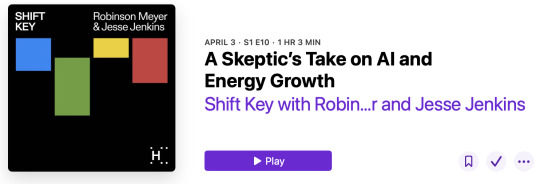
This conversation was a fun one. here's the description:
Will the rise of machine learning and artificial intelligence break the climate system? In recent months, utilities and tech companies have argued that soaring use of AI will overwhelm electricity markets. Is that true — or is it a sales pitch meant to build more gas plants? And how much electricity do data centers and AI use today? In this week’s episode, Rob and Jesse talk to Jonathan Koomey, an independent researcher, lecturer, and entrepreneur who studies the energy impacts of the internet and information technology. We discuss why AI may not break the electricity system and the long history of anxiety over computing’s energy use. Shift Key is hosted by Robinson Meyer, executive editor of Heatmap, and Jesse Jenkins, a Princeton professor of energy systems engineering.
Listen on Apple Podcasts.
Listen on Spotify.
Listen on Audible.
0 notes
Text
An updated vignette of technology change for lighting
In 2011, we replaced lighting cans with LED inserts in our house, instantly reducing lighting energy use by 50% or more. The inserts looked like the ones on the left in the photos below.
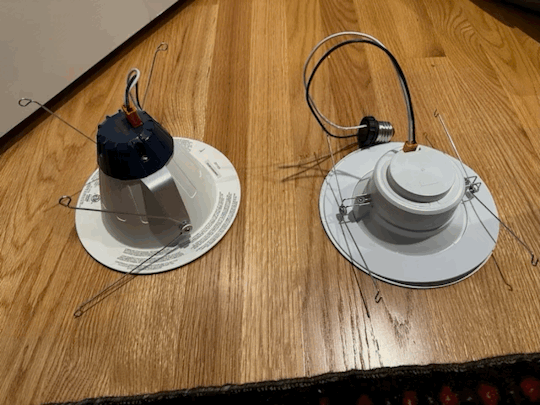

Recently (September 2023) I needed to buy a few more to replace some of the old ones that failed. The new ones look like the one on the right in the photos. Both give 700 lumens of light output.
The old ones (with the little wire that screws into the socket) weigh 486 grams, use 11 W, have a color temperature of 3000 K, are about 11.9 cm high, and cost $50 each.
The newest ones weigh 226 grams, use 10 W, have a more pleasing color temperature of 2700 K, are about 6.3 cm tall, cost $11 each, and occupy less than half the volume of the 2011 version.
In a dozen years the price has come down a factor of nine, volume and weight are down by a factor of two (making shipping easier and less expensive), efficiency has improved about 9%, and lighting quality has improved. Not too shabby!
Technological progress like this is why Amory Lovins calls efficiency a renewable resource. It keeps getting better and cheaper over time!
For an intermediate look at the state of this technology in 2019, go here.
0 notes
Text
The 8th annual roundup episode of Chris Nelder's Energy Transition show
Every year since Chris Nelder started the Energy Transition Show, he's interviewed me for the annual roundup episode, and this year is no exception. We discuss the proper role of government in a capitalist economy, climate change doomism, how the fossil fuel industry rigs the system, and the difficulties of the mid-transition as we shift away from conventional energy systems.
The full episode is here:
If you're not a subscriber, you can still hear a free abridged version on the Apple podcast app and elsewhere.
#climate change#climate solutions#information technology#forecasting#energy efficiency#greenhouse gas emissions#energy transition
0 notes
Text
Our commentary titled “Abandon the idea of an ‘optimal economic path’ for climate policy” came out on July 2nd, 2023 in WIRES Climate Change
I, along with colleagues at World Resources Institute and Koomey Analytics, just had a commentary published in WIRES Climate Change. It’s titled “Abandon the idea of an ‘optimal economic path’ for climate policy”.
Many economic modelers think that if given enough time, money, graduate students, and coffee they can estimate an “optimal economic path” for climate mitigation that extends far into the future. They further argue that this path is the correct or best way to guide climate policy design.
The most prominent example is that of Nobel prize winning professor William Nordhaus, the father of cost-benefit or benefit-cost analysis for climate [1]. In his 2018 Nobel acceptance speech, Nordhaus [2] said:
[I]n the view of most economists, balancing of costs and benefits is the most satisfactory way to develop climate policy.
[O]ne of the most amazing results of Integrated Assessment Models (IAMs) is the ability to calculate the optimal carbon price…This concept represents the economic cost caused by an additional ton of carbon dioxide emissions (or more succinctly carbon) or its equivalent…In an optimized climate policy (abstracting away from various distortions), the social cost of carbon will equal the carbon price or the carbon tax.
Nordhaus argues that IAMs can estimate carbon prices that optimize global consumption, emissions, and climate change, balancing mitigation or abatement costs against benefits of reducing emissions (like risk reduction and avoided climate damages). Similar analyses, focused on damage costs, are used to assess appropriate social costs of carbon for regulatory purposes [3].
This way of framing the problem can be summarized in the following graph, which depicts benefit and cost curves in stylized fashion. It characterizes the place where the two curves cross as the “optimal” level of GHG reductions, where the marginal cost of reducing emissions is equal to the marginal benefits from reducing them. The point also suggests the optimal carbon price, as in the Nordhaus quotation above. In this view, reducing emissions beyond that point would imply that we are paying too much for emissions reductions because the costs for incremental emissions reductions would exceed the benefits.
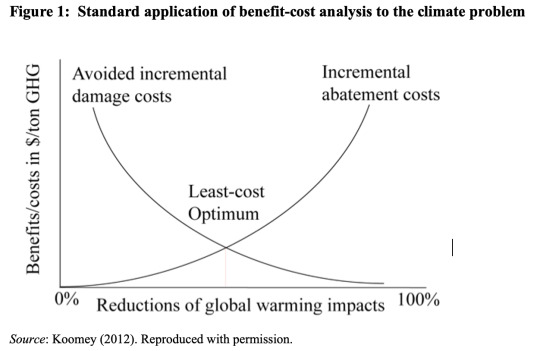
This commentary focuses attention on underlying ideas about “optimal paths” that are in our view not widely enough understood and are often unstated, namely that
(1) there IS a single unique optimal path to solving the climate problem,
(2) this path exists independent of human choices, and
(3) society can discover this path in advance through better data collection, analysis, and logical thinking.
These beliefs are at odds with our current understanding of the forces driving the development of real economic and technological systems, which are dominated by increasing returns to scale, network externalities, learning curves, and other non-linear effects. Real non-linear systems are subject to “sensitive dependence on initial conditions”, which leads to chaotic and often unpredictable behavior of such systems in the face of imperfect measurements, randomness, and human choices [4, 5, 6, 7, 8]. Models of non-linear systems are also strongly affected by uncertainties in model structure, complicating things still further [9].
The full reference for the commentary is
Koomey, Jonathan, Zachary Schmidt, Karl Hausker, and Dan Lashof. 2023. "Abandon the idea of an “optimal economic path” for climate policy." Invited Commentary for WIREs Climate Change. vol. e850, July 2. [http://doi.org/10.1002/wcc.850]
To download a pre-publication version of the article, click here.
References
1. Nordhaus, William D. 1992. "An Optimal Transition Path for Controlling Greenhouse Gases." Science. vol. 258, no. 5086. pp. 1315. [http://science.sciencemag.org/content/258/5086/1315.abstract]
2. Nordhaus, William D. 2018. Nobel Prize Lecture, December 8, 2018 [https://www.nobelprize.org/prizes/economic-sciences/2018/nordhaus/lecture/]
3. US EPA. 2022. Report on the Social Cost of Greenhouse Gases: Estimates Incorporating Recent Scientific Advances. Washington, DC: U.S. Environmental Protection Agency. September. [https://www.epa.gov/environmental-economics/scghg]
4. Lorenz, Edward. 1995. The essence of chaos. Seattle, WA: The University of Washington Press. [https://uwapress.uw.edu/book/9780295975146/the-essence-of-chaos/]
5. Gleick, James. 1988. Chaos: Making a new science. New York, NY: Penguin Books. [https://amzn.to/3Jxc2yv]
6. DeCanio, Stephen J. 2013. Limits of Economic and Social Knowledge. New York, NY: Palgrave Macmillan. [https://stephendecanio.com/2017/06/30/limits-of-economic-and-social-knowledge/]
7. Pluchino, Alessandro, Alessio Emanuele Biondo, and Andrea Rapisarda. 2018. "Talent versus luck: The role of randomness in success and failure." Advances in Complex Systems. vol. 21, no. 03n04. pp. 1850014. [https://www.worldscientific.com/doi/abs/10.1142/S0219525918500145]
8. Dizikes, Peter. 2011. "When the butterfly effect took flight." In MIT Technology Review. February 22. pp. [https://www.technologyreview.com/2011/02/22/196987/when-the-butterfly-effect-took-flight]
9. Thompson, Erica. 2022. Escape from model land: How mathematical models can lead us astray and what we can do about it. New York, NY: Basic Books. [https://amzn.to/3HDxH5t]
0 notes
Text
I participated in a symposium on Technology and Global Change at Oxford last week
A quarter century ago, Arnulf Grübler published a book titled Technology and Global Change.
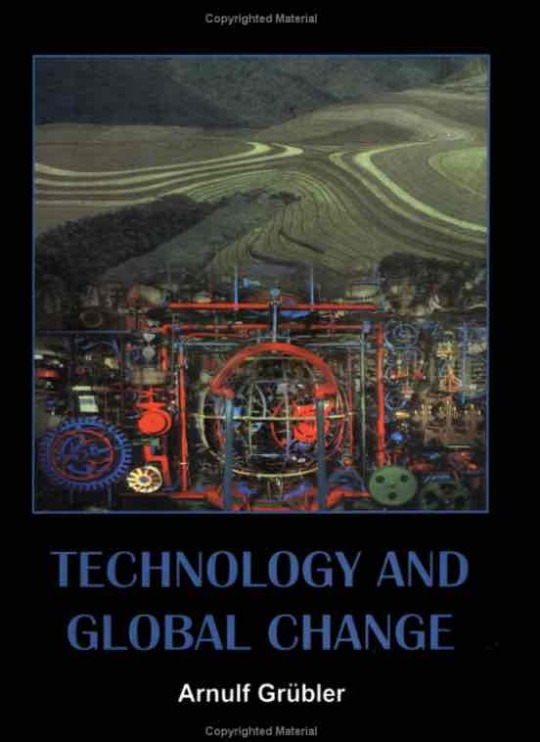
On June 19th and 20th, 2023, students and colleagues of Arnulf gathered at Oxford for a symposium to honor him and discuss data and methods for understanding technology and global change for the next twenty five years.
The workshop was organized by Charlie Wilson of Oxford and Greg Nemet at the University of Wisconsin, Madison, and was attended by a stellar cast of researchers and practitioners, some of whom I knew, others I was glad to have met for the first time at the workshop.
Here’s a photo of the full cast of characters:

Here’s a photo from our dinner on June 20th:
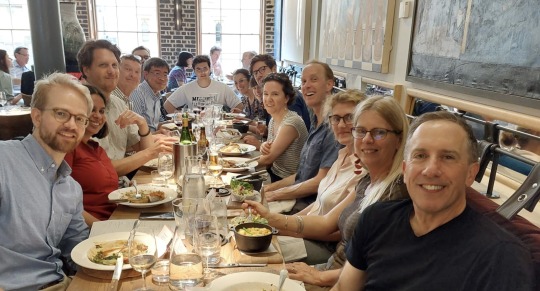
My talk for the symposium, titled “A rapid tour of long-term trends in the energy efficiency of information technology”, summarized the state of the data on this important topic. You can download it here.
#Technology and Global Change#Arnulf Grubler#Oxford#Information Technology#Forecasting#Data Analysis
0 notes
Text
We talked with Allyson Klein at Tech Arena for her June 23rd podcast about our book, Solving Climate Change

Ian Monroe and I talked with Allyson Klein at Tech Arena for her podcast about our book, Solving Climate Change: A Guide for Learners and Leaders. It’s a half hour conversation that covers many of the key lessons from our textbook. We think you’ll enjoy it.
https://www.thetecharena.net/content/solvingclimatechange
Allyson was at Intel for many years and I had talked with her back in 2012 (and probably more recently) about ICT electricity use on her “Chip Chat” interview show.
For more on the book, see
https://www.solveclimate.org and
https://iopscience.iop.org/book/mono/978-0-7503-4032-8
Our live webinar was 10 May 2023 as posted on Physics World, but you can use the same link to view the recorded version.
https://physicsworld.com/a/solving-climate-change-with-jonathan-koomey-and-ian-monroe/
The 1st chapter, free download: https://iopscience.iop.org/book/mono/978-0-7503-4032-8/chapter/bk978-0-7503-4032-8ch1
Instructors can request an examination copy from IOP publishing: shorturl.at/qrLM0
0 notes
Text
Questions that came up at our webinar about our book, Solving Climate Change: A Guide for Learners and Leaders
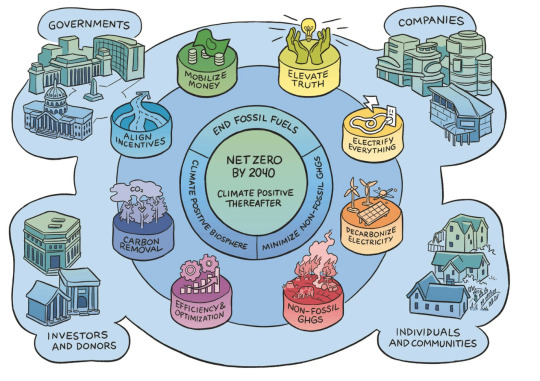
On May 10, 2023, Ian Monroe and I gave a live webinar for the Institute of Physics (IOP) about our latest book, Solving Climate Change: A Guide for Learners and Leaders. The webinar is still posted at the Physics World website, and if you register you can watch it on demand:
https://physicsworld.com/a/solving-climate-change-with-jonathan-koomey-and-ian-monroe/
Other links to the book and related materials:
http://www.solveclimate.org
https://iopscience.iop.org/book/mono/978-0-7503-4032-8
The 1st chapter, free download: https://iopscience.iop.org/book/mono/978-0-7503-4032-8/chapter/bk978-0-7503-4032-8ch1
Instructors can request an examination copy from IOP publishing: shorturl.at/qrLM0
After that webinar, four questions came back from the audience. Ian and I answered them, and I thought it would be good to post them here as well.
If you listen to the webinar or read the book and have questions, Email me and we’ll add them to the list of answered questions so others can benefit.
Question 1: For an individual with limited reach, do you have any advice when it comes to dealing with friends and family that are unwilling to listen to these facts and change their behavior to minimize their impact? It can be quite frustrating while having to deal with climate anxiety as well.
Getting people to change their habits is hard, but we need all levels of action to decarbonize our global economy. One of the most important things is to vote for politicians who promise real climate action, because the SYSTEM needs to change to get the emissions reductions we need. Politicians are much more likely to enact good climate policies if individual voters are demanding them, and individual spending and investment decisions can also influence companies who then influence politicians. Most people already support renewable energy and energy efficiency because they save people money and are cleaner than fossil alternatives.
To change people’s behavior, we’ve found that leading with the benefits of new technology (distinct from emissions reductions) can often be effective. Electric vehicles are cheaper to run, are cleaner, and are more fun to drive. Electric heat pumps generate no carbon monoxide, are quieter, are often cheaper to run, and are cheaper to install when replacing a furnace/AC combo (because heat pumps replace two pieces of equipment with one). Switching to electric cooking also improves indoor air quality, reducing the likelihood of asthma. Eating plant-based foods and reducing red meat generally improves overall health.
There are some online resources that can help. This one is great (and funny):
https://crankyuncle.com
A more technical resources is Skeptical Science, which compiles and refutes common myths about climate change and solutions.
https://skepticalscience.com
Another important resource on climate solutions is Project Drawdown:
https://www.drawdown.org
Question 2: In Mexico City we have students that spend a lot of time getting to college, sometimes 1 or 2 hours to arrive there. To promote remote work and less commuting, do you recommend online courses, in particular for engineering and sciences students? Teachers are reluctant to this change.
We are huge fans of remote work and study. As Amory Lovins says, move the electrons, leave the heavy nuclei at home! It’s vastly less emissions intensive to conduct lessons remotely. It takes different preparation for professors but it’s not clear that it takes more preparation, and the benefits are big, not just for climate, but also for quality of life. While it can be hard to fully replace the benefits of in-person instruction, hybrid systems where remote instruction is paired with limited in-person meetings can provide similar benefits, and we have increasingly better tools for replicating in-person experiences with online alternatives (which younger generations often prefer).
Question 3: You didn’t seem to mention reducing energy use. Is it wise not to assume this will happen?
Using energy more efficiently is great, but in the book we focus on what we call emissions efficiency and optimization, because energy efficiency is too narrow a frame for this problem. There is no question that we can reduce waste and eliminate unproductive uses of energy, but when energy is produced renewably, it may be just fine from an emissions perspective to use more.
In addition, the switch to electricity, which eliminates many sources of losses in combustion when electricity is generated from renewables, will result in a substantial increase in electricity use while significantly reducing fossil fuel energy use. Combustion losses are so significant in the current economy (somewhere around 20-30 % of total primary energy) that eliminating them will result in substantial energy savings for society even as electricity use goes up.
Question 4: I wish to know what actions can be taken in developing economies that depend on oil so well & are not anywhere near the expected green electrification needed to achieve a net zero carbon emissions footprint.
There is no need for developing countries to repeat our mistakes, especially since the alternatives to fossil fuels are now cheaper in societal terms virtually everywhere and cheaper in direct cost terms in many cases. There is no case for expanding fossil fuel infrastructure anywhere on the planet (with very few exceptions). Most electrification, renewable energy, and other climate solution technologies have even greater economic, health, and wellbeing benefits for developing economies that currently suffer proportionally more from existing fossil fuel and unsustainable agriculture pollution and economic distortion. Most fossil infrastructure expansion proposals are now being driven by fossil fuel interests because they want to lock in users as much as possible before serious emissions reductions begin. Their strategy is what the futurist Alex Steffen correctly calls “predatory delay”.
Electrifying two wheeled vehicles is already happening rapidly in the developing world, as is deployment of renewables in some places. China is now by far the world’s leader in scaling up electric vehicle, and while China now leads in electric car, bus, and truck production, China started by producing hundreds of millions of electric scooters and bikes, which cost less to run than the fossil-fueled vehicles they replace. The key is to overcome the power of vested interests, who want to delay action for as long as possible (because it benefits them).
Another step many countries can take is to protect natural areas from further destruction, to maintain the ecosystem services they provide while responsibly developing industries (like tourism) that thrive when forests and other natural systems are healthy.
0 notes
Text
Our latest book, Solving Climate Change, freely downloadable through May 21, 2023

Solving Climate Change: A Guide for Learners and Leaders, was released in late December 2022. The publisher, IOP, recently made if freely downloadable through May 21, 2023, so get it while it’s still free!
Download it here:
https://iopscience.iop.org/book/mono/978-0-7503-4032-8
The main website for the book is here:
http://www.solveclimate.org
Our live webinar was 10 May 2023 as posted on Physics World, but you can use the same link to view the recorded version.
https://physicsworld.com/a/solving-climate-change-with-jonathan-koomey-and-ian-monroe/
The 1st chapter will always be a free download, even after May 21st: https://iopscience.iop.org/book/mono/978-0-7503-4032-8/chapter/bk978-0-7503-4032-8ch1
After May 21st, instructors can request an examination copy from IOP publishing: shorturl.at/qrLM0
If you have ideas for people/institutions who should review the book, please let me know.
0 notes
Text
My talk at the Salinas, CA Rotary Club on Feb 9, 2023, focused on misconceptions about information technology energy and environmental impacts
My talk on February 9, 2023 for the Salinas Rotary club is an expansion of points made in a commentary article by me and Professor Eric Masanet, UCSB, in Joule in 2021:
Koomey, J., & Masanet, E. (2021). Does not compute: Avoiding pitfalls assessing the Internet's energy and carbon impacts. Joule, 5(7), 1625-1628. https://www.sciencedirect.com/science/article/abs/pii/S2542435121002117.
In the talk, I presented nine different high-profile misconceptions about electricity use and emissions associated with computing, explored four pitfalls that lead to such misconceptions, and suggested four ways we can do better in the future.
Here is a graph illustrating that substantial increases in information technology services, in this case data flows, does not necessarily imply increases in energy use.

Here is the conclusions slide:

You can download a PDF of the slides (which include three pages of references) HERE.
0 notes
Text
Our commentary on the need for targeted programs affecting networked standby power for information technology

The peer-reviewed journal Energy Efficiency just published our commentary about networked standby power and the need for product-specific government industry interactions when setting voluntary targets and standards. Networked standby is power used by devices to maintain a network connection, and some states and countries are considering regulating it using what are called “horizontal standards” for standby power that apply to many different kinds of products.
The purpose of this commentary is to explain why we think even “clustered horizontal” targets, like the ones currently being analyzed by the California Energy Commission (Pasha 2021), will be challenging to develop for devices incorporating information and communication technology. We don’t think it is impossible to create horizontal targets in all cases, but we are convinced, because of the fast-moving nature of these technologies and the increasing integration of IT with the primary functions of most devices, that horizontal targets of any type (even more precisely targeted ones) will face unique headwinds.
Please email me if you don’t have access via the DOI link below or click on the sharing link above (in the first paragraph). The supplemental information is a white paper that contains more technical analysis and details supporting our arguments in the commentary.
Abstract
Efficiency of electronic devices is an area of active interest by policy makers in the European Union and elsewhere. Efforts to create a uniform horizontal efficiency standard (one that applies to many different types of equipment) have worked in the past, but as standards become more stringent, the need for product-by-product differentiation for such standards becomes more pressing.
Devising sensible regulations requires making reasonable average power consumption estimates for groups of components that reflect how they would actually be used in real products, not just treating components in isolation. Deep interactions between regulators and manufacturers are often needed to create efficiency targets that improve efficiency without sacrificing innovation. There are models of such interactions that have proven to work well (like the processes for developing Energy Star voluntary programs, many minimum efficiency standards, and industry voluntary agreements) that represent the best path forward.
References
Koomey, Jonathan, Zachary Schmidt, Bruce Nordman, Kieren Mayers, and Joshua Aslan. 2023. "Successful efficiency programs for information and communication technologies require product-specific analysis and industry/government collaboration." Energy Efficiency. vol. 16, no. 1. 2023/01/18. pp. 2. [https://doi.org/10.1007/s12053-023-10083-y]
Pasha, Soheila. 2021. Staff Presentation: Low Power Mode Roadmap. Sacramento, CA: California Energy Commission. [https://www.energy.ca.gov/event/workshop/2021-08/staff-workshop-appliance-efficiency-roadmap-low-power-mode-data-collection]
0 notes
Text
Our latest book, out today: Solving Climate Change: A Guide for Learners and Leaders
Our latest book was just released online today by IOP Publishing (The Institute of Physics). It’s called Solving Climate Change: A Guide for Learners and Leaders.
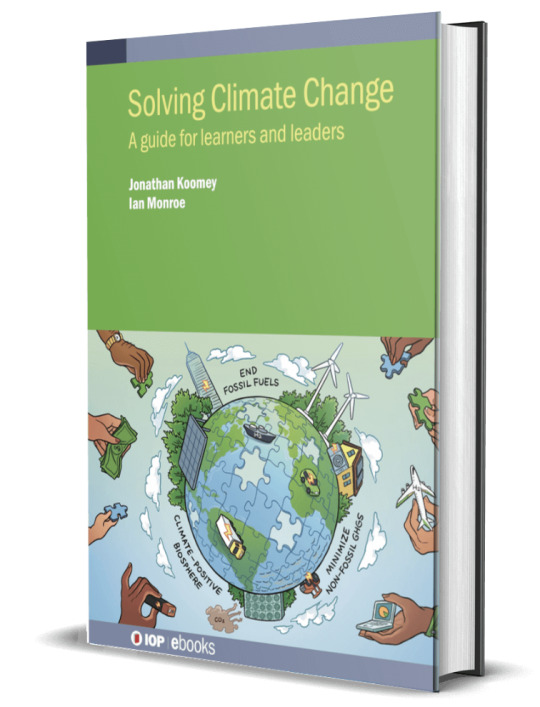
The publisher’s page for the book is https://doi.org/10.1088/978-0-7503-4032-8.
This textbook grew out of a course my colleague Ian Monroe and I taught at Stanford in 2017 and 2018, titled “Implementing Climate Solutions at Scale”. Its intended audience is academics and practitioners teaching classes like that one, though we hope others will also find it useful.
We posted some key parts of the book online:
Table of contents
Preface
Foreword by Professor Kimberly Nicholas
This book goes beyond our original courses to provide a more comprehensive framework for solving climate change than we’ve found elsewhere. We include an overview of climate solution technologies, as well as analytical tools necessary to identify solutions that really work. We also explore what’s needed to align incentives, mobilize money, and elevate truth in climate conversations, key pillars of climate action that are often overlooked by techno-centric discussions of global emissions reductions.
The overarching framing of the book (*the eight pillars of solving climate change”) is summarized in this graphic:

Please do reach out to me and Ian with questions, ideas for outreach, and suggestions for the next edition. You can also sign up for our mailing list by going to http://www.solveclimate.org and paging down a bit on the first page. Finally, if your institution has a library, please put in a request for them to purchase the book. It’s priced on the high side ($120), as textbooks often are, so it may be out of reach for many individuals, but libraries and companies should be able to afford it.
0 notes
Text
Our latest article on scenario decomposition tools was published in September 2022
Our latest article on scenario decomposition tools came out in Environmental Modeling and Software in September 2022:
Koomey, Jonathan, Zachary Schmidt, Karl Hausker, and Dan Lashof. 2022. "Exploring the black box: Applying macro decomposition tools for scenario comparisons." Environmental Modeling and Software. vol. 155, September. [https://doi.org/10.1016/j.envsoft.2022.105426]
This article is a follow on to our 2019 article in the same journal:
Koomey, Jonathan, Zachary Schmidt, Holmes Hummel, and John Weyant. 2019. "Inside the Black Box: Understanding Key Drivers of Global Emission Scenarios." Environmental Modeling and Software. vol. 111, no. 1. January. pp. 268-281. [https://www.sciencedirect.com/science/article/pii/S1364815218300793]
The 2022 article applies the tools developed in the 2019 article to two aggressive emissions reduction scenarios, illustrating the kinds of insights available from using these tools. We apply a Logarithmic Mean Divisia Index (LMDI) decomposition to analyze emissions reductions from the energy sector and additional tools to assess emissions reductions from other sectors.
These are the two articles containing the scenarios we compared:
Grübler, Arnulf, Charlie Wilson, Nuno Bento, Benigna Boza-Kiss, Volker Krey, David L. McCollum, Narasimha D. Rao, Keywan Riahi, Joeri Rogelj, Simon De Stercke, Jonathan Cullen, Stefan Frank, Oliver Fricko, Fei Guo, Matt Gidden, Petr Havlík, Daniel Huppmann, Gregor Kiesewetter, Peter Rafaj, Wolfgang Schoepp, and Hugo Valin. 2018. "A low energy demand scenario for meeting the 1.5 °C target and sustainable development goals without negative emission technologies." Nature Energy. vol. 3, no. 6. 2018/06/01. pp. 515-527. [https://doi.org/10.1038/s41560-018-0172-6]
van Vuuren, Detlef P., Elke Stehfest, David E. H. J. Gernaat, Maarten van den Berg, David L. Bijl, Harmen Sytze de Boer, Vassilis Daioglou, Jonathan C. Doelman, Oreane Y. Edelenbosch, Mathijs Harmsen, Andries F. Hof, and Mariësse A. E. van Sluisveld. 2018. "Alternative pathways to the 1.5 °C target reduce the need for negative emission technologies." Nature Climate Change. 2018/04/13. [https://doi.org/10.1038/s41558-018-0119-8]
Here’s one example of our dashboards, comparing results for two scenarios:

Email me for a copy if you don’t have access.
0 notes